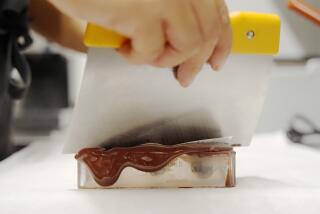Passion Fruit: Squeeze, Don’t Bite
- Share via
The flavor of the passion fruit is as enchanting as its name. But woe to the neophyte who tries to bite into it like an apple. The edible part of the fruit--the pulp--comes in a leathery, bitter-tasting shell. In the unlikely event your teeth make it through, the bright orange pulp will squirt messily all over your clothing.
The easiest way to eat a passion fruit is to cut it in half with a sharp knife, working over a bowl to catch the juices. Inside the egg-sized sphere you’ll find a perfumed, juicy, orange pulp, comprised of hundreds of tiny juice sacs, each with a crunchy black seed in the center.
The flesh of the passion fruit has the tartness of lime juice, the sweetness of honey, the fragrance of jasmine and a perfumed flavor reminiscent of guava, lychee and pineapple. Small wonder people are passionate about it from the Caribbean to South America, and from Africa to Asia.
Passion fruit takes its name not from the emotion it inspires when eaten, but from the curious shape of its flower. Each part of the blossom is said to symbolize an aspect of the passion of Christ. The five stamens, for example, are said to represent Christ’s five wounds, explains fruit expert Alan Davidson. The three styles symbolize the three nails; the round ovary, the vinegar-soaked sponge; the 12 petals, the 12 apostles; and the spiky corona above the petals, the crown of thorns.
Passion fruit arrived in North America, in Florida to be exact, as early as 1887, but it didn’t catch on as a fruit until the 1980s. The Florida Tropical Fruit Advisory Council estimates that, prior to Hurricane Andrew, there were about 65 acres of passion fruit planted in southern Florida, with an annual harvest of 75,000 pounds. Hawaii is also a major producer of passion fruit, locally called lilikoi; and limited quantities are grown in California.
These numbers pale in comparison with the more than 8.5 million pounds of passion fruit grown annually elsewhere in the world, reported by exotic fruit expert Elizabeth Schneider. But domestic production will surely increase as more Americans discover this exquisitely aromatic fruit.
Domestic passion fruit is in season from August to January. Brazil and New Zealand assure a steady supply the rest of the year. Look for passion fruit in upscale supermarkets, gourmet greengrocers and Hispanic and Asian markets. In areas with a large Hispanic population, passion fruit is often sold by its Spanish name, maracuja.
When buying passion fruit, look for large, bright-yellow or purple spheres that feel heavy in your hand. You should be able to hear the juice slosh around when you shake the fruit. It’s normal for passion fruit to look creased or partially deflated. In fact, if it’s too round, it may not be fully ripe. Passion fruit will keep for a week to 10 days in the refrigerator and can be frozen.
A great alternative to the fresh fruit is the frozen passion fruit pulp sold at Hispanic markets and gourmet shops. The frozen pulp has the dual advantage of being inexpensive and seedless.
One passion fruit yields about one tablespoon of intensely flavored pulp. A little goes a long way. In fact, most people use fresh passion fruit as a flavoring rather than a primary ingredient, like a splash of orange liqueur or vanilla extract.
The tiny black seeds are edible. Indeed, I rather like their brittle crunch. If you don’t enjoy the seeds, you can sieve the pulp through a strainer.
Passion fruit is usually associated with desserts. Its perfumed flavor goes well with mousses and pastries, while its acidity provides a nice counterpoint to sugar and other sweeteners. But passion fruit makes an equally welcome addition to savory dishes, especially chicken, duck and pork. I like to add a tablespoon of fresh passion fruit pulp to French beurre blanc to make a tropical sauce for grilled fish.
Here is a recipe for passion fruit daiquiri, designed for offbeat summertime sipping.
*
The daiquiri originated in 19th-Century Cuba, where its principal ingredients were lime juice, rum and sugar. Today, daiquiris are made throughout the Caribbean with a multitude of fruits. The following recipe will give you an entirely new perspective on this classic cocktail.
PASSION FRUIT DAIQUIRI 5 to 6 fresh passion fruits or 1/3 cup frozen, strained pulp, thawed 1/4 cup light rum 1 to 2 tablespoons sugar 1 teaspoon fresh lime juice 1 cup crushed ice 2 hibiscus flowers or fresh mint sprigs for garnish
Cut passion fruit in half and scrape out pulp. Force pulp through strainer (there should be 4 to 5 tablespoons). Place in blender along with rum, sugar, lime juice and ice and process until smooth. Taste and adjust flavoring, adding sugar or lime juice to taste.
Pour daiquiri into martini glasses. Garnish each with hibiscus flower and serve at once. Makes 2 servings.
More to Read
Eat your way across L.A.
Get our weekly Tasting Notes newsletter for reviews, news and more.
You may occasionally receive promotional content from the Los Angeles Times.










